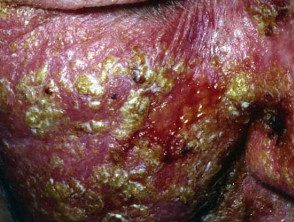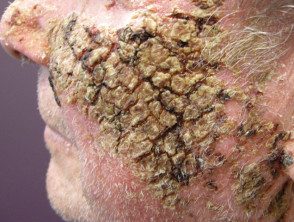What is fluorouracil? cream?
Current Fluorouracil cream at 5% is often abbreviated to 5-FU. The brand name in New Zealand is Efudix ™ and it is a prescription drug. Is a cytotoxic agent or antimetabolite and it's toxic to living cells, especially certain Cancer or precancerous cells. It destroys sun damaged skin cells, making the skin appear smoother and younger.
In many countries, a 0.5% fluorouracil cream combined with 10% salicylic acid (Actikerall®) is also available.
Reaction to fluorouracil cream after 2 weeks of use in actinic keratoses
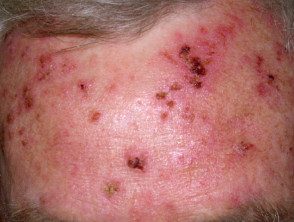
Actinic keratosis treated with fluorouracil cream

Effects of fluorouracil cream applied to actinic keratoses
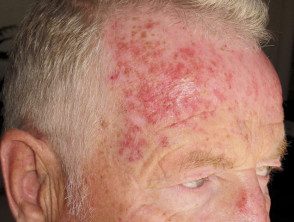
Effect of 17 days of fluorouracil cream for actinic keratoses
How does fluorouracil work?
Fluorouracil is a pyrimidine. analog term which irreversibly binds within a cell to thymidylate synthetase. This prevents the incorporation of uracil into nuclear RNA, which destroys abnormal cancer cells.
What is fluorouracil used for?
Fluorouracil cream is most often prescribed to clarify actinic keratosis and intraepidermal carcinoma (in the place scaly cell carcinoma). A full course has been shown to substantially reduce the risk of cutaneous squamous cell carcinoma (SCC) that develops at the treated site in the following year.
Fluorouracil is also occasionally used to treat the following skin conditions:
- Superficial basal cell carcinoma
- Psoriasis
- Viral warts
- Genital warts
- Disseminated superficial porokeratosis and linear porokeratosis
It works best on the face and scalp and is less effective elsewhere on the body.
How should fluorouracil cream be used?
Fluorouracil cream is a powerful and destructive medicine and should be used exactly as directed. Keep it closed so that other people cannot mistakenly use it to treat a eruption.
Pretreatment with cryotherapy or keratolytics, such as urea cream or glycolic acid lotion, it is useful to minimize climbing and allows optimal absorption of the active ingredient, 5-FU.
Fluorouracil cream is applied once or twice a day after washing under running water. A small amount of the cream should be gently rubbed into all treatment areas with your fingertips. It is important to apply it to all skin and not only to visible lesions. Then rinse your finger well with water (or use a glove or cotton swab to apply the cream). Treatment for actinic keratoses is continued for 2 to 4 weeks. More time may be required for treatment of squamous cell carcinoma in situ.
The manufacturer's guidelines indicate that the maximum area to be treated at the same time is 500 cm.2.
Treatments combined with fluorouracil cream
Sometimes fluorouracil cream is prescribed in combination with another topical agent.
- The combination of 5% fluorouracil cream with tretinoin cream works best if tretinoin has been used for at least two weeks before starting fluorouracil. Tretinoin cream improves the effect of fluorouracil by removing the top layer of the skin. Reduces the time required for the course of fluorouracil treatment. Tretinoin cream can then be continued over the long term to reduce signs of skin aging and prevent deterioration, using very careful sun protection.
- The combination of low potency 0.5% fluorouracil cream with 10% salicylic acid> (Actikerall ™) has also been shown to be effective for actinic keratoses on the face, hands and forearms over a 12-week course. It is especially useful for hyperkeratotic Injuries (corneas).
- Fluorouracil cream at 5% with calcipotriol at 0.005% ointment improvement reported effectiveness and reduce the number of days required for the treatment of actinic keratoses compared to fluorouracil cream 5% alone.
Fluorouracil wraps
Fluorouracil wrappers, also known as chemowraps, are an office occlusive treatment for extensive field treatment for actinic keratoses and intraepidermal carcinomas. They are most often used to treat severely sun damaged legs. After cleaning the area to be treated, a thick layer of fluorouracil cream is applied to scaly lesions and surrounding skin, often circumferentially around the limb. About 10 to 20 g of 5-FU are used for each limb. Paraffin gauze is applied to fluorouracil cream in areas of movement (eg, ankle) as protection. The limb is then bandaged carefully with loose layers of zinc oxide (to improve healing and reduce pain), cotton bandage and crepe or self-adhesive compression roller.
The chemical wrap is left in place for 7 days and then removed. The treated skin is gently washed and rubbed to remove loose skin and scabs. Fluorouracil treatment is repeated once a week for 4 to 12 weeks. If the treated areas erode, the treatment is suspended and petroleum jelly is applied to the affected area. It can be recommended again if necessary.
What are the results of treatment with fluorouracil cream?
Fluorouracil cream often produces a mild to severe itching or burning sensation, depending on the sensitivity of the skin, the severity of sun damage, and how long it has been used. After five to ten days of treatment, the sun-damaged parts of the treated skin become red, scaly, and tender. As treatment continues, sores and scabs may appear. These rough areas result from the destruction of faulty skin cells. They are a necessary part of treatment and are expected to heal once treatment is stopped.
Treated areas can be covered with a light dressing or left open. An occlusive dressing will increase the penetration of 5-FU and improve the effect and Adverse reactions. Makeup can be used if the reaction is mild, but should be avoided in the case of erosions and ulceration.
Organize for your dermatologist, a GP or nurse for skin cancer to check you during treatment to check progress and determine how long you should continue to use fluorouracil cream. If any unusual or severe reaction occurs, stop applying it and contact your healthcare professional.
Fluorouracil cream effect

Mild reaction after 10 days of keratosis treatment.
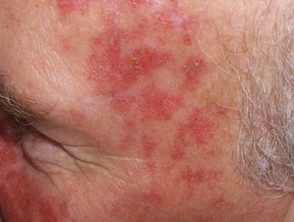
Keratosis after 2 weeks of treatment.
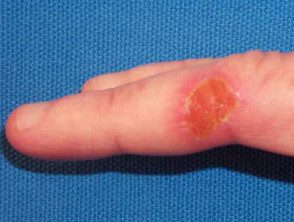
Ulcerative intraepidermal carcinoma after 3 weeks of treatment.
Precautions when using fluorouracil cream
Fluorouracil cream should not be used during pregnancy because it has been shown to cause birth defects. It is classified as Category D. It should also be avoided during breast-feeding, to minimize the possibility of excretion in breast milk and the subsequent risk for the infant.
Avoid putting fluorouracil cream in the eyes; not normally used on the eyelids. Keep it away from your lips, unless specifically instructed to use it on this site. Use it gently on skin folds (such as those around the nose and lips), as it can irritate more severely in these areas.
Due to interaction with sunlight, it is best to use fluorouracil cream during the winter months. Normally treated skin should be very carefully protected from the sun; stay indoors for half the day. If the treated area is accidentally exposed to the sun, the reaction to fluorouracil is more vigorous than normal.
Follow-up after fluorouracil treatment
After you have been instructed to stop using fluorouracil cream, you may be prescribed a specific moisturizer or mild topical steroid. When treatment is stopped, the skin heals quickly. It takes two to four weeks for healthy new skin to replace sun-damaged skin destroyed by fluorouracil cream. After healing, the treated areas are often redder than normal and may feel more tender; This redness and tenderness will gradually fade over a few weeks. Occasionally it persists for several months. Persistent or recurrent actinic keratoses can be treated with an additional course of fluorouracil cream, imiquimod cream or cryotherapy. However, it is important to ask your dermatologist if this is appropriate because skin cancers can be very similar and may need surgery or other procedures. The action of fluorouracil cream means that there is some degree of itching, pain, erosions, crust, dermatitis and another inflammatory Reactions are expected during treatment. The following complications may occasionally occur during treatment with fluorouracil cream. The following complications may follow treatment with fluorouracil cream: Excessive inflammatory reactions to fluorouracil cream Excessive inflammatory reactions to fluorouracil cream Excessive inflammatory reactions to fluorouracil creamComplications of treatment with fluorouracil cream.
Excessive inflammatory reactions to fluorouracil cream

